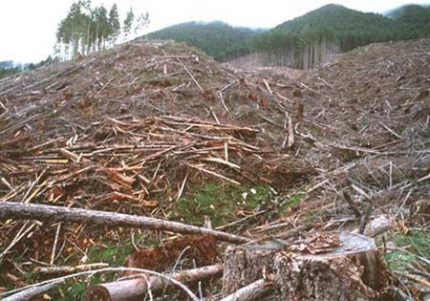
TimberWest SFI-certified logging near Lake Cowichan, Vancouver Island, 2003
Key weaknesses in the Sustainable Forestry Initiative
Like PEFC , the SFI standard was developed and approved largely for the industry by the industry, rather than by a balance of environmental, social and economic interests. Whilst the Sustainable Forestry Board (SFB), which has governed most of the recent changes to the SFI standard, does include some conservation groups, the forest industry still controls two-thirds of the votes.
The SFI standard does not address social issues, particularly in terms of indigenous peoples' rights, and it is also weak with regard to most ecological issues. Consequently, SFI-certified companies continue to log old-growth and endangered forests, destroy the habitat of rare and endangered species and replace natural forest with plantations. The standard also allows permanent conversion of forests to uses such as urban sprawl - in one case certifying an operation where forest land is being turned into a 1,000 home suburban development, with the timber labelled as coming from sustainable forestry.
Any company wishing to become SFI-certified has considerable influence over the certification process. For example, the applicant company can work with the certification body to tailor the scope, location and extent of the audit, the composition of the audit team, the audit plan and the audit report content. Participants also define their own corrective actions. There is no stakeholder consultation in this process.
The SFI standard does not address social issues, particularly in terms of indigenous peoples' rights, and it is also weak with regard to most ecological issues. Consequently, SFI-certified companies continue to log old-growth and endangered forests, destroy the habitat of rare and endangered species and replace natural forest with plantations. The standard also allows permanent conversion of forests to uses such as urban sprawl - in one case certifying an operation where forest land is being turned into a 1,000 home suburban development, with the timber labelled as coming from sustainable forestry.
Any company wishing to become SFI-certified has considerable influence over the certification process. For example, the applicant company can work with the certification body to tailor the scope, location and extent of the audit, the composition of the audit team, the audit plan and the audit report content. Participants also define their own corrective actions. There is no stakeholder consultation in this process.
In most cases SFI does not track timber from the forests to the shop
Normally, SFI does not require tracking of SFI-certified wood from the forest through manufacturing to labelling and allows uncertified timber from other plantations and forests to be labelled as SFI-certified, as long as an independent third party checks that the timber supplier has an SFI procurement system in place. There are no requirements for certifiers to assess the actual source or the chain of custody of such timber. This means that up to 100% of an SFI-labelled product may come from forests which do not meet the full SFI standard.
The 'legal and sustainable' status accorded by CPET applies only to a new percentage based claims system created by the SFI. Currently no SFI certified company is using this chain of custody system so it remains to be seen how effective this system will be in terms of UK Government procurement.
Read Greenpeace Canada's report Forest certification: Green stamp of approval or Rubber Stamp of Destruction?
The 'legal and sustainable' status accorded by CPET applies only to a new percentage based claims system created by the SFI. Currently no SFI certified company is using this chain of custody system so it remains to be seen how effective this system will be in terms of UK Government procurement.
Read Greenpeace Canada's report Forest certification: Green stamp of approval or Rubber Stamp of Destruction?


